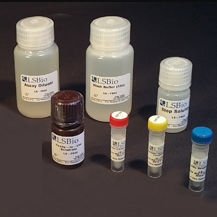
- Laboratory
- Laboratory medicine
- Research test kit
- LifeSpan BioSciences
Research assay kit LS-K297for drug discoveryfor ASTNAD
Add to favorites
Compare this product
Characteristics
- Applications
- for research
- Application field
- for drug discovery
- Tested parameter
- for AST, NAD, glutamate
- Sample type
- blood, serum
- Analysis mode
- colorimetric
- Result display time
10 min
- Sample volume
0.02 ml
(0.00068 US fl oz)
Description
Aspartate Transaminase (AST), also known as serum glutamic oxaloacetic transaminase (GOT) or aspartate aminotransferase (ASAT/AAT), facilitates the conversion of aspartate and a-ketoglutarate to oxaloacetate and glutamate. There are two isoenzymes in humans: GOT1 is a cytosolic isoenzyme derived from red blood cells and heart; GOT2 is the mitochondrial isoenzyme found mainly in the liver. AST is elevated in liver and muscle diseases. It is part of diagnostic tests for liver function, myocardial infarction, acute pancreatitis, acute hemolytic anemia, severe burns, acute renal disease and trauma. Simple, direct and automation-ready procedures for measuring AST activity find wide applications in research and drug discovery. This AST activity assay is based on the quantification of oxaloacetate produced by AST. In this assay, oxaloacetate and NADH are converted to malate and NAD by the enzyme malate dehydrogenase. The decrease in NADH absorbance at 340 nm is proportionate to AST activity.
Specifications
Type
Detection/Quantition
Usage
For quantitative determination of aspartate transaminase (AST) activity and evaluation of drug effects on AST activity.
Target
Aspartate Transaminase
Detection
Colorimetric (340 nm Absorbance)
Supplied Components
The following components are supplied with this product.
Assay Buffer
Cofactor
Enzyme Mix
NADH Reagent: Dried
(See Datasheet for specific volumes supplied)
Applications
Spectrophotometry (visible)
Equipment
Microplate spectrophotometer (visible), Spectrophotometer (visible)
Conditions
Shipped -20°C Dry Ice, Store at -20°C, 6 months shelf life.
Catalogs
No catalogs are available for this product.
See all of LifeSpan BioSciences‘s catalogsRelated Searches
- Assay kit
- Solution reagent kit
- Blood assay kit
- Serum assay kit
- Immunoassay assay kit
- Plasma assay kit
- Research reagent kit
- Protein reagent kit
- Laboratory reagent kit
- Optical assay kit
- Immunology reagent
- Buffer solution reagent kit
- Fluorescence assay kit
- ELISA assay kit
- Antigen assay kit
- Research assay kit
- Laboratory detection kit
- Cell assay kit
- Urine assay kit
- Tissue detection kit
*Prices are pre-tax. They exclude delivery charges and customs duties and do not include additional charges for installation or activation options. Prices are indicative only and may vary by country, with changes to the cost of raw materials and exchange rates.








































